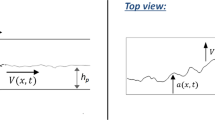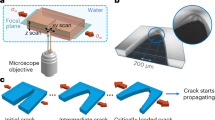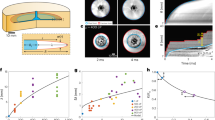Abstract
Crack propagation is the basic mechanism of materials failure. Experiments on dynamic fracture in brittle amorphous materials have produced results1 that agree with theoretical predictions for single-crack motion at very low velocities. But numerous apparent discrepancies with theory have been observed2,3,4 at higher velocities. In particular, the maximum crack velocities attained in amorphous materials are far slower than the predicted asymptotic value, vR (ref. 3). Beyond a critical velocity, vc ≈ 0.4vR, an intrinsic instability has been observed5 in which a multiple-crack state is formed by repetitive, frustrated micro-branching events. These cause velocity oscillations and may explain the apparent anomaly. Here we report measurements of dynamic fracture in a brittle, amorphous material that are in quantitative agreement with the theoretical single-crack equation of motion, from the initial stages of propagation up to vc. Beyond vc, agreement breaks down owing to the appearance of the multiple-crack ensemble. But in this regime, the micro-branching process can momentarily produce a single-crack state which instantaneously attains its predicted single-crack velocity, for velocities up to 0.9vR. Our results therefore confirm the validity of the single-crack continuum theory of elastic brittle fracture even in the dynamical regime where the crack morphology is complex.
This is a preview of subscription content, access via your institution
Access options
Subscribe to this journal
Receive 51 print issues and online access
$199.00 per year
only $3.90 per issue
Buy this article
- Purchase on Springer Link
- Instant access to full article PDF
Prices may be subject to local taxes which are calculated during checkout



Similar content being viewed by others
References
Bergkvist, H. Some experiments on crack motion and arrest in polymethylmethacrylate. Eng. Fracture Mech. 6, 621–626 (1974).
Sharon, E. & Fineberg, J. Microbranching instability and the dynamic fracture of brittle materials. Phys. Rev. B 54, 7128–7139 (1996).
Ravi-Chandar, K. & Knauss, W. G. An experimental investigation into dynamic fracture. III. On steady-state crack propagation and crack branching. Int. J. Fracture 26, 141–154 (1984).
Ravi-Chandar, K. & Knaus, W. G. An experimental investigation into dynamic fracture. II. Microstructural aspects. Int. J. Fracture 26, 65–80 (1984).
Fineberg, J., Gross, S. P., Marder, M. & Swinney, H. L. Instability in the propagation of fast cracks. Phys. Rev. B 45, 5146–5154 (1992).
Marder, M. & Liu, X. M. Instability in lattice fracture. Phys. Rev. Lett. 71, 2417–2424 (1993).
Marder, M. & Gross, S. Origin of crack tip instabilities. J. Mech. Phys. Solids 43, 1–48 (1995).
Xu, X. P. & Needleman, A. Numerical simulations of fast crack growth in brittle solids. J. Mech. Phys. Solids 42, 1397–1437 (1994).
Johnson, E. Process region changes for rapidly propagating cracks. Int. J. Fracture 55, 47–63 (1992).
Lobkovsky, A. & Langer, J. S. Critical examination of cohesive-zone models in the theory of dynamic fracture. J. Mech. Phys. Solids 46, 1521–1526 ((1998)).
Ching, E. S. C., Langer, J. S. & Nakanishi, H. Dynamic instabilities in fracture. Phys. Rev. Lett. 76, 1087–1090 (1996).
Freund, L. B. Dynamic Fracture Mechanics (Cambridge Univ. Press, New York, (1990)).
Sharon, E., Gross, S. P. & Fineberg, J. Local crack branching as a mechanism for instability in dynamic fracture. Phys. Rev. Lett. 74, 5096–5099 (1995).
Sharon, E., Gross, S. P. & Fineberg, J. Energy dissipation in dynamic fracture. Phys. Rev. Lett. 76, 2117–2120 (1996).
Boudet, J. F., Ciliberto, S. & Steinberg, V. Dynamics of crack propagation in brittle materials. J. Phys. II 6, 1493–1516 (1996).
Abraham, F. F., Brodbeck, D., Rafey, R. A. & Rudge, W. E. Instability dynamics of fracture—a computer simulation investigation. Phys. Rev. Lett. 73, 272–275 (1994).
Zhou, S. J., Lomdahl, P. S., Thomson, R. & Holian, B. L. Dynamic crack processes via molecular dynamics. Phys. Rev. Lett. 76, 2318–2321 (1996).
Vu, B. Q. & Kinra, V. K. Brittle fracture of plates in tension. Static field radiated by a suddenly stopping crack. Eng. Fracture Mech. 15, 107–114 (1981).
Washabaugh, P. D. & Knauss, W. G. Areconciliation of dynamic crack velocity and rayleigh wave speed in isotropic brittle solids. Int. J. Fracture 65, 97–114 (1994).
Morrissey, J. W. & Rice, J. R. Crack front waves. J. Mech. Phys. Solids 46, 467–487 (1998).
Acknowledgements
We thank L. B. Freund for supplying us with finite-element calculations of G(l). This work was supported by the US-Israel Binational Fund.
Author information
Authors and Affiliations
Corresponding author
Rights and permissions
About this article
Cite this article
Sharon, E., Fineberg, J. Confirming the continuum theory of dynamic brittle fracture for fast cracks. Nature 397, 333–335 (1999). https://doi.org/10.1038/16891
Received:
Accepted:
Issue Date:
DOI: https://doi.org/10.1038/16891
This article is cited by
-
Complexity of crack front geometry enhances toughness of brittle solids
Nature Physics (2024)
-
Effect of load level on cracking of L-shaped soda-lime glass specimens
Glass Structures & Engineering (2023)
-
Study on the pore/scratch-strength response of ZrB2–SiC ceramic via laser processing
Journal of the Korean Ceramic Society (2022)
-
Experimental study of multi-timescale crack blunting in hydraulic fracture
Petroleum Science (2021)
-
Peridynamic analysis of dynamic fracture: influence of peridynamic horizon, dimensionality and specimen size
Computational Mechanics (2021)
Comments
By submitting a comment you agree to abide by our Terms and Community Guidelines. If you find something abusive or that does not comply with our terms or guidelines please flag it as inappropriate.



